Exploring the Allure of Paint Horses
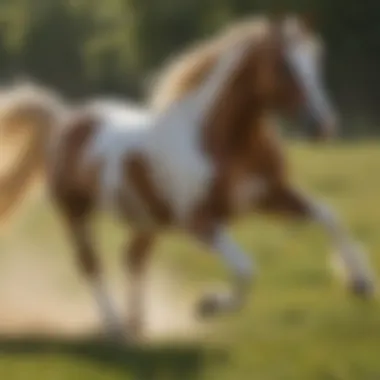
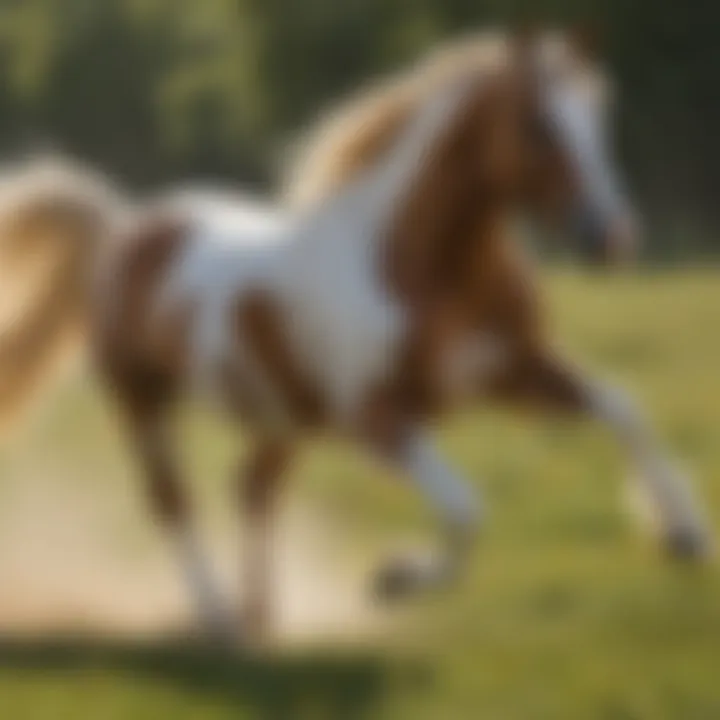
Intro
The enchanting world of paint horses captures the imagination of many. With their vivid patterns and robust presence, these creatures are not just animals but living canvases, each unique in its artistry. As someone who appreciates the aesthetics of paint horses, it’s essential to understand their characteristics, the culture surrounding them, and the role of photography in showcasing their beauty. This understanding not only enhances our appreciation but also fosters a deeper connection to these remarkable animals.
In the sections to follow, we will explore various facets related to paint horses, beginning with their care and grooming. It's crucial to lay the groundwork for ensuring their well-being through proper maintenance practices. From there, we’ll transition into discussing their health and nutritional needs, before addressing behavioral training aspects that are pivotal for their happiness and adaptability. We will also delve into engaging activities that enrich their lives and finally, connect with resources and community engagement opportunities that bring together paint horse enthusiasts.
Pet Care and Grooming
Caring for paint horses involves a blend of attentiveness and practical know-how. Regular care is of utmost importance; it ensures these beautiful creatures stay healthy and continue to thrive. It’s not just about aesthetics; their coat and overall condition can tell a lot about their health.
Importance of Regular Care
Regular care goes beyond beauty. Neglect can lead to various health issues, from skin irritations to more serious illnesses. Implementing a consistent grooming routine helps in early detection of problems. Ensuring their hooves are trimmed, mane tidy, and coat shiny reflects the owner’s commitment to their well-being.
Grooming Techniques by Horse Type
Grooming isn't a one-size-fits-all activity. For paint horses, their unique markings and varying coat types require tailored approaches. Here’s how:
- Short-haired coats: Use a stiff brush to clear dirt, followed by a softer brush for finishing touches.
- Long-haired individuals: A wide-tooth comb prevents tangling, which is common in longer manes and tails.
Tools and Products Recommendations
Choosing the right tools is essential. Some recommended tools include:
- Curved hoof rasp for trimming and maintaining hooves.
- Soft bristle brushes to avoid skin irritation.
- Detangler spray to manage long hair.
Seasonal Care Tips
Each season brings its own challenges:
- In summer, increased sweat can lead to skin issues, so bath them regularly and check for bumps.
- Winter requires more attention to warmth. A good blanket can make all the difference in keeping them cozy during colder months.
Health and Nutrition
Equally important is understanding the health and nutrition of paint horses. Proper nutrition affects their physical health, appearance, and performance.
Understanding Pet Nutrition
Paint horses need a balanced diet that includes hay, grains, and supplements. Observing their energy levels can indicate if they are underfed or overfed.
Common Health Issues by Species
Awareness of potential health issues is key. These might include:
- Colic: A common digestive issue that can be life-threatening if not addressed promptly.
- Laminitis: Often linked to dietary mismanagement or abrupt diet changes.
Preventive Care and Regular Check-Ups
Regular check-ups with a veterinarian are essential. Good practice can include:
- Vaccination updates
- Dental examinations every six months
Food and Dietary Advice
Consulting a nutritionist can be beneficial. It’s crucial to tailor a diet suited for their specific demands, depending on age, size, and activity level. High-quality hay and grains are advisable, as well as fresh water at all times.
Behavioral Training
A well-trained horse makes a valuable companion. Training isn't just for discipline; it builds trust and improves the bond between horse and owner.
Basics of Positive Reinforcement
Using positive reinforcement is an effective training technique. It includes:
- Treats
- Praise This encourages horses to repeat desired behaviors, focusing on their strengths rather than correcting flaws.
Training Techniques Users Can Apply
Simple techniques for users to try:
- Lunging: Allows the horse to stretch while also practicing commands.
- Groundwork: Establishes leadership and improves communication.
Managing Behavioral Issues
Behavioral issues can be challenging. Common ones include:
- Biting or kicking: Typically a sign of fear or discomfort. Identifying the root cause is fundamental.
- Refusal to lead: This may require additional trust-building exercises.
Importance of Socialization
Socialization with other horses and even with different environments reduces anxiety and builds confidence. It’s beneficial for their overall demeanor, making them more adaptable.
Engaging Activities and Enrichment
Paint horses are intelligent creatures and require mental stimulation. Boredom can lead to behavioral problems.
Fun Games to Play with Your Pet
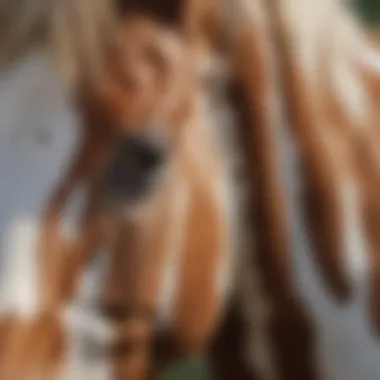
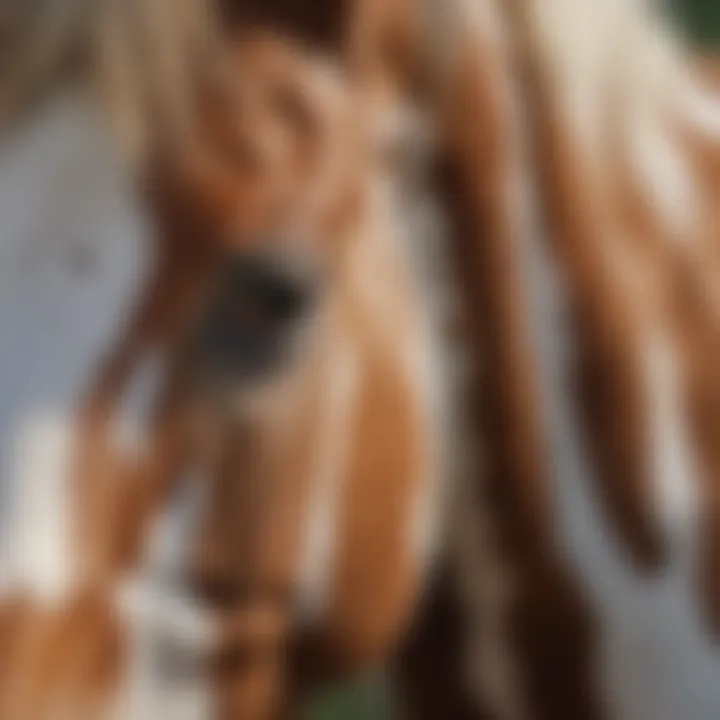
Engaging activities can include:
- Obstacle courses: Encourages them to think and maneuver.
- Hide and seek with treats: Develops their natural instincts and sharpens their mind.
DIY Toys and Activities
Creating toys from natural materials not only entertains them but can also be cost-effective. For example, using old tires for a play area or hanging apples on ropes can keep them active.
Importance of Mental Stimulation
Mental challenges are just as crucial as physical ones. Puzzles or simple training exercises keep their brains engaged and happy.
Outdoor Adventures and Exploration
Exploring new terrains and environments can introduce your paint horse to novel sights and sounds, an enriching experience that can vastly improve their disposition.
Resources and Community Engagement
Connecting with a broader community can enhance the experience of owning a paint horse, providing vital resources and sharing knowledge.
Recommended Books and Websites
Consider these resources:
- "The Horse Encyclopedia" by Elwyn Hartley Edwards: Provides an extensive overview of various breeds, including paints.
- Wikipedia Paint Horse for a thorough historical overview.
Forums and Groups for Pet Owners
Joining communities like Reddit can help new owners share experiences or seek advice from others who share their passion for paint horses.
Finding Local Services and Classes
Many areas offer workshops on horse care, riding lessons, or activities. Seeking these out fosters skill development and community engagement.
Encouraging Community Sharing and Contributions
Connection with other paint horse enthusiasts can lead to a wealth of knowledge. Encouraging exchanges of tips, stories, and even photos nurtures a sense of community and support amongst owners.
By understanding every aspect surrounding paint horses, one develops a deeper love and connection with these unique animals. Their beauty, both in visual appeal and character, enriches our lives.
Prelude to Paint Horses
Paint horses captivate many horse lovers with their striking appearance and rich history. Understanding the significance of these magnificent creatures lays the foundation for a deeper appreciation and knowledge of equine culture. This section introduces the unique elements that make paint horses stand out, setting the stage for further exploration of their characteristics, aesthetic appeal, and cultural relevance.
Understanding the Breed
Paint horses are recognized not just for their distinct color patterns but also for their dynamic personalities and historical roots. They can be traced back to early Spanish explorers, who brought horses to North America. Over the years, paint horses have developed a reputation for their versatility and adaptability, making them a popular choice for a variety of disciplines, from ranch work to competitive events. With a blend of American Quarter horse and Thoroughbred genes, paint horses possess strength and agility, which appeal to owners and riders alike.
Characteristics of Paint Horses
The characteristics of paint horses provide a fascinating glimpse into what makes them special. From their color patterns to their physical attributes, every aspect contributes to their charm and popularity.
Color patterns
Color patterns are arguably the most distinguishing feature of paint horses. They exhibit a unique blend of white and colored patches, creating a visual spectacle that attracts attention on any pasture. The most common patterns include Overo, Tobiano, and Tovero, each with its own distinct look. The benefit of owning a paint horse lies in the wide variety of appearances. Notably, the uniqueness of each horse means no two paint horses look alike, adding a layer of individuality for collectors and enthusiasts. However, prospective owners should be aware that some patterns may come with genetic predispositions to specific health issues, which is a consideration for any buyer.
Physical attributes
The physical attributes of paint horses are equally impressive. Standing between 14.2 to 16.2 hands high, these horses are known for their muscular build and robust stature. The combination of strength and grace makes them suitable for various equestrian activities. High-quality conformation is often a focus in breeding paint horses, ensuring that they possess athletic ability in addition to their stunning color. However, potential buyers should consider that not all paint horses will fit for every discipline due to physical limitations or specific breeding traits.
Temperament
Temperament is another key aspect of paint horses that attracts many owners. Known for their friendly and sociable nature, they typically exhibit a calm demeanor, making them suitable for riders of all experience levels. A paint horse’s willingness to engage with people adds to its appeal, fostering a strong bond between animal and rider. However, it’s important to note that proper training is essential, as each horse's personality can vary widely. A horse with a gentle temperament might still require consistent leadership to navigate its environment successfully.
In summary, the introduction to paint horses illuminates not only their beauty but also their multi-dimensional characteristics. Understanding their breed, unique color patterns, physical attributes, and engaging temperament provides invaluable insight for those looking to delve deeper into the world of equine companions.
The Aesthetic Appeal of Paint Horses
The aesthetic appeal of paint horses is a crucial element in understanding their allure and the impact they have on both enthusiasts and casual observers alike. With their striking colors and captivating patterns, paint horses are not just animals; they are living art. This section seeks to unveil the vibrant beauty of paint horses through their unique color patterns and the importance of visual documentation. By examining these aspects, readers can appreciate not only the breed’s visual appeal but also the deeper connections it fosters within the equestrian community.
Distinctive Color Patterns
Paint horses come in a variety of patterns, each with its own unique charm and significance. These distinctive color patterns are a reflection of a horse's genetics and are part of what makes paint horses so visually enticing.
Overo
The Overo pattern presents a beautiful mosaic of colors, typically characterized by irregular patches that do not cross the back. This unique feature can range from solid white patches to large areas of color, which gives the Overo its distinctive look. The key characteristic of the Overo pattern is its unpredictability; no two horses will feature the same arrangement of colors and shapes. As a breed choice popular among enthusiasts, Overo horses often stand out in shows and competitions due to their eye-catching designs.
However, the Overo color pattern does come with its own set of considerations. For instance, some Overos are prone to certain genetic conditions like Overo Lethal White Syndrome, which can pose challenges for breeders and owners. Therefore, understanding these aspects is vital for anyone considering this captivating pattern.
Tobiano
Tobiano horses, on the other hand, showcase a more structured pattern with white spots that typically cross the back and often extend down the legs. The Tobiano was the toast of western rodeos for some time due to its cheerful appearance and striking white markings. The combination of white with a base color creates a stark contrast that truly captivates spectators.
As a choice for owners, Tobianos are appreciated for their consistent appearance and are often viewed as versatile performers in various disciplines. Their striking aesthetics draw fans in at shows or competitions, but it's worth noting that they may require special grooming to maintain their coats and visual appeal.
Tovero
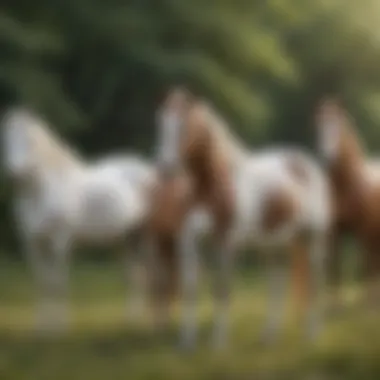
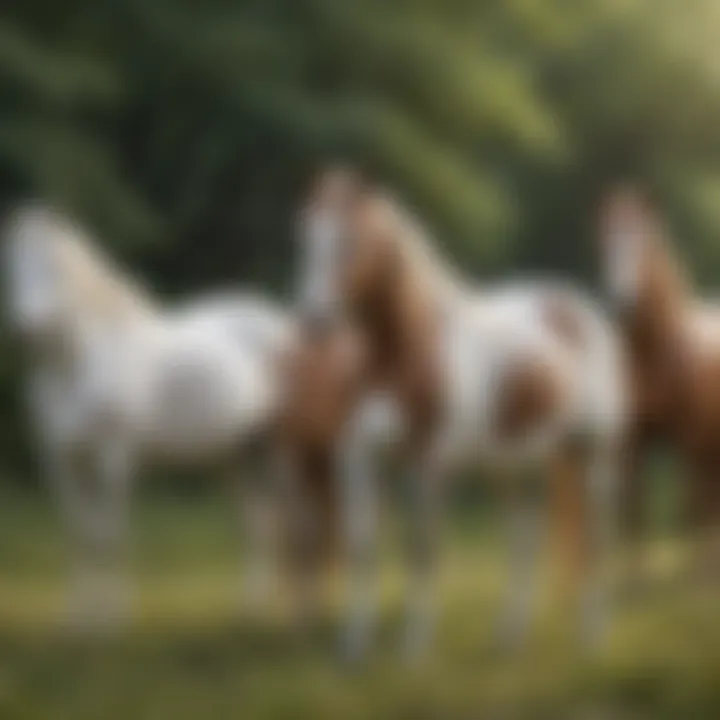
Tovero horses combine characteristics of both Overo and Tobiano patterns, resulting in a horse that is both dynamic and visually arresting. The key feature of the Tovero pattern is the mixture of spots that are large and bold. This unique feature sets them apart from purely Overo or Tobiano horses, making them a favored option for those looking for something a bit different in appearance.
The allure of Tovero horses lies in their eclectic aesthetics and rich color mix, attracting many enthusiasts who value individuality. However, it’s crucial to research their lineage as some Toveros may carry the same genetic risks as their Overo counterparts.
Visual Documentation
Visual documentation of paint horses serves as a powerful tool in capturing their essence and showcasing their beauty. Photographers have the unique opportunity to exhibit the lively patterns and intricate details that make the paint horse so special. Using different techniques, one can highlight the horse's elegance and vitality in various settings.
From local shows to vast pastures, documenting their movement and spirit can inspire owners, breeders, and fans alike. Effective photography hones in on key aspects like lighting and angles, ensuring every photograph tells a story of the horse's heritage and individuality.
"A photograph can capture a moment in time, but it can also convey the deep connection between rider and horse, a bond that radiates through the lens."
Overall, the artistic interpretation of paint horses captured through photography not only embellishes their aesthetic appeal but also serves as a conduit for appreciation among enthusiasts and the general public alike.
Cultural Significance of Paint Horses
Understanding the cultural importance of paint horses goes beyond their striking appearances; it reveals how deeply intertwined they are with human history and traditions. Paint horses carry with them a legacy that resonates with various communities, embodying both aesthetic value and practical significances in our cultural fabric. They serve as symbols of freedom, loyalty, and the spirit of the American West. This unique breed connects with people on multiple levels, from being companions to cultural icons in literature and art.
Historical Context
Historically, paint horses have roots tracing back to the indigenous peoples of North America. The first notable instances of these horses were seen among Native American tribes who valued them for their resistance, agility, and striking color patterns. The patterns often reflected their owners’ identities and tribal affiliations. Over the years, these horses transitioned from utilitarian companions for work and transport to becoming treasured figures in popular culture. The arrival of European settlers introduced some new breeding techniques, and the paint horse gradually found a spot in American lore.
Let's dive a little deeper into their evolution:
- Native tribes utilized paint horses for hunting and trade.
- Their distinctive color patterns often had ceremonial significance.
- With westward expansion, this breed became associated with cowboys and ranch culture, further entrenching its position in American narratives.
Paint Horses in Art and Media
Art has always had a fascinating way of capturing various aspects of life, and the depiction of paint horses is no exception. Their unique genetics, which give rise to vibrant patterns, have made them an enduring muse in both traditional and modern art forms.
Famous artworks
Artworks featuring paint horses have contributed immensely to the visual representation of this breed. Many artists, such as Charles Marion Russell and Frederic Remington, have immortalized these remarkable animals on canvas. The brush strokes combined with the colors reminiscent of the paint horse's coat create an immediate emotional connection with the viewer. The beauty of these pieces lies not only in their aesthetic appeal but also in their storytelling capability.
- Key characteristic: The use of color and detail that reflects the horse's traits—this draws viewers into the subject's essence.
- Contribution: These artworks highlight the cultural importance and allure of paint horses, giving us a window into the historical significance of these creatures.
- Unique feature: The ability to blend realistic representation with artistic imagination allows for a rich interpretation of paint horses, enhancing their reputation.
Film representation
In cinema, paint horses like those seen in the flick "The Horse Whisperer" are often portrayed as noble creatures, aiding protagonists in finding their inner strength. This representation acts as a testament to the bond between humans and horses, often emphasizing themes of friendship and loyalty.
- Key characteristic: Paint horses often symbolize deeper narratives about freedom and exploration, representing human struggles and triumphs.
- Contribution: Films featuring paint horses create a layered cultural narrative that invites audiences to reflect on the roles animals play in our lives.
- Unique feature: By showcasing paint horses in various media, it brings awareness to equine welfare, adoption, and responsible ownership.
The significance of paint horses in art and media extends beyond mere visuals; they are a bridge connecting generations and cultures, a blend of history, emotion, and identity that captivates hearts worldwide.
"Paint horses symbolize more than beauty; they are messengers of stories as old as the land itself."
The Role of Photography in Capturing Paint Horses
When it comes to paint horses, photography plays a vital role. It captures the beauty, diversity, and intricate patterns that set these horses apart. With the right photographs, one can appreciate not only the unique color combinations but also the delightful characteristics these animals embody. A great image can tell stories, evoke emotions, and ignite interest in the breed, making photography an indispensable tool for enthusiasts and prospective owners alike.
Techniques for Photographing Horses
Lighting considerations
Lighting is often the unsung hero in photography, especially when it comes to animals like paint horses. The right lighting can enhance the colors and textures of the horse's coat. For instance, golden hour—just after sunrise or before sunset—provides a soft, warm light that beautifully accentuates the horses' unique patterns. It can create a cozy atmosphere and highlight the natural sheen of their fur.
However, balancing light is critical. Too much sunlight can wash out colors, while too little could result in dark images lacking detail and vivacity. Using reflectors or bounces to direct light can also help showcase the horse's features more effectively without creating harsh shadows. This attention to light and tone contributes significantly to ensuring the photographs capture the essence of these magnificent creatures.
Angles and composition
The angle from which a photograph is taken can completely transform the way paint horses are perceived. Low angles—shooting from below—can confer a sense of grandeur, making the horse appear imposing and majestic. Conversely, capturing them from slightly above adds relatability, making it easy to see their expression and temperament.
Composition is equally important; following techniques like the rule of thirds can help create a visually appealing photograph. By placing the horse off-center, photographers can lead the viewer's eye and create a dynamic feel within the frame. Additionally, framing the horse against contrasting backgrounds can emphasize their color patterns, setting them apart in the landscape.
Photographers Who Specialize in Equine Photography
Many photographers dedicate themselves to equine photography, focusing on capturing the beauty of horses, particularly paints. These artists understand not just how to shoot but also how to connect with the animals. They often spend time getting to know the horse’s personality and quirks, assisting in bringing out the most authentic expressions in front of the lens.
The work of seasoned equine photographers often goes beyond just snapping photos; they grasp the nuances of horse behavior, allowing them to capture those fleeting moments that truly showcase the breed's character. Some photographers even have roots in the equestrian community, giving them a deeper understanding of what to photo shoot and how to engage with both horses and their owners.
Overall, the world of paint horse photography is rich, textured, and filled with possibilities. From the thoughtful use of light and angles to the expertise of skilled photographers, every element intertwines to present these beautiful animals in their best light. As the paint horse community grows, so does the demand for stunning images that tell their stories.
Caring for Paint Horses
Caring for Paint Horses is not simply a routine; it’s a labor of love. These striking animals require specific attention to their nutritional needs, training, and overall well-being. Understanding how to provide for a Paint Horse enriches the owner’s experience and fortifies the bonds that exist between horse and human.
Nutrition Requirements
The nutrition of Paint Horses is crucial, influencing everything from their energy levels to their coat's sheen. These horses thrive on a balanced diet of fiber, protein, vitamins, and minerals. Hay forms the cornerstone of their diet, providing essential roughage. Alfalfa hay, rich in protein, can be more suitable for young, active horses, while grass hay is better for adult horses trying to maintain a healthy weight.
When it comes to grain, it should be mixed according to individual horse needs. Feeding a premade grain mix can simplify this, but be careful; overloading on grain can lead to problems like colic or laminitis.
Furthermore, supplementing with vitamins specific to their geographical climate can be beneficial. A good balance of omega-3 and omega-6 fatty acids supports skin and coat health, which is particularly important for Paints, known for their distinctive color patterns. Regular consultation with a veterinarian or equine nutritionist helps in identifying deficiencies or adjusting diets based on activity levels.
Ultimately, the better the diet, the better the horse looks and performs. An owner must stay attuned to the horse’s needs, adjusting feeds as necessary, ensuring a well-rounded care regimen.
Training for Paint Horses
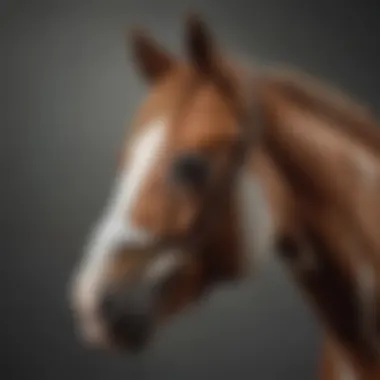

Training is a vital aspect of Paint Horse care. It's not just about teaching commands; it fosters respect and understanding between horse and handler, laying a solid groundwork for a harmonious relationship.
Basic commands
Basic commands, such as walk, trot, and whoa, are the bedrock of training. They establish a two-way communication channel, essential in all equestrian disciplines. Teaching these commands early hones the horse’s responsiveness and helps mold their behavior.
An obvious advantage of mastering basic commands is safety. For instance, teaching a Paint to stop on command can prevent accidents during riding or handling situations. Moreover, clear commands aid in effective training sessions, minimizing frustration for both horse and rider. The unique aspect of basic commands is their foundation; they serve as a gateway to more advanced maneuvers, ultimately expanding a horse’s skill set. However, owners should be mindful of the horse's temperament—some may grasp commands swiftly, while others need more patience and time.
Behavioral nuances
Understanding behavioral nuances is equally important in training. Every Paint Horse has its idiosyncrasies. Some might be more skittish than others, affected by their environment or past experiences. Recognizing these behaviors allows an owner to tailor training methods that address their specific needs.
For instance, a horse that frequently spooks at loud sounds may benefit from gradual desensitization techniques. A key characteristic here is the need for a stable, calm approach. An enlightened handler not only trains commands but also builds an atmosphere of trust.
Moreover, being aware of behavioral shifts can forewarn of health issues. For example, sudden changes in attitude or behavior could signal discomfort or disease, warranting further investigation. This nuanced understanding enhances the overall training experience, fostering patience and a deeper connection with the animal.
"The bond between horse and human is forged through understanding and respect, turning a simple act of training into a shared journey."
In summary, caring for Paint Horses encompasses much more than mere feeding and training. It is a layered approach that combines nutrition, physical and mental welfare, and ongoing education about each horse’s unique needs. This comprehensive care is what makes owning a Paint Horse such a rewarding endeavor.
Community and Enthusiast Groups
The fabric of paint horse culture is enriched by various community and enthusiast groups. For anyone keen on understanding paint horses beyond the surface, these groups play a crucial role. They foster connection among owners, provide resources for new horse lovers, and create a platform for sharing knowledge and experiences related to these stunning animals. Being part of such a community can also amplify one’s passion for painting horses while exploring their history and characteristics.
Joining a Paint Horse Association
Connecting with a Paint Horse Association can be rewarding. Membership offers access to a treasure trove of information, including breed specifics, training techniques, and health tips. These associations often publish newsletters and host forums where members can engage in discussions and get answers to their queries.
Furthermore, joining such groups can provide a sense of belonging. Participants often form friendships based on shared interests, leading to collaborative learning. Also, many associations organize educational events, which allow members to deepen their knowledge while networking with other paint horse enthusiasts.
Events and Competitions
Local Shows
Local shows present an accessible way for paint horse owners to showcase their horses. These events generally foster a friendly environment where individuals can put their training to the test. Local shows tend to emphasize community engagement, making them a popular choice, especially for newcomers who want to dip their toe into competitive waters without the pressures of larger competitions.
A notable characteristic of local shows is their intimate nature. Participants can interact more easily, making for a relaxed atmosphere. Since local shows often have fewer categories, competitors can focus on honing specific skills, thus improving their performance gradually. However, the downside may include limited exposure to broader styles or techniques when compared to larger competitions.
National Competitions
On the other hand, national competitions offer a more intense and competitive environment. These events attract seasoned participants, providing an opportunity to see some of the best paint horses in the country. Engaging in national competitions can be seen as a pinnacle for many enthusiasts, serving to highlight the skill and talent of both the horses and their riders.
The key characteristic of national competitions is their extensive scale and variety of categories. Participants can gain exposure to different styles, testing their horses against a wider range of challenges. However, the level of competition can be intimidating for some, and the costs involved—like travel and preparation—might be a consideration.
Both local and national events contribute immensely to the community aspect of paint horse culture, cultivating a richer understanding of the breed and offering avenues for networking and friendship.
"The community of paint horse enthusiasts is like a family; it grows stronger with each event and gathering, bound by a shared love for these incredible animals." – Anonymous
Challenges Facing Paint Horse Owners
Understanding the challenges facing paint horse owners is crucial for anyone looking to engage seriously in this realm. These challenges not only include the care and maintenance of these unique animals but also reflect broader societal and environmental issues concerning horse ownership. The complexities of health, breed preservation, and other factors serve as critical points of discussion, that, when navigated wisely, can enhance the overall experience for both horse and owner.
Common Health Issues
Paint horses, like many breeds, are susceptible to specific health issues that every owner should be aware of. Understanding these conditions can help in early detection and treatment, ultimately leading to a healthier life for the horse.
Some common health issues include:
- Laminitis: This painful condition affects the hooves and can severely impact a horse's ability to move comfortably. It often arises from dietary issues or sudden changes in feed.
- Colic: A broad term describing abdominal pain, colic can result from various causes, including diet and stress. Owners must be aware of the signs, such as rolling or sweating, to respond swiftly.
- Skin Conditions: Paint horses can suffer from skin issues due to their distinctive coat patterns, which may affect the underlying skin differently than in solid-colored horses. Proper grooming and hygiene can help prevent various dermatitis conditions.
- Genetic Disorders: Certain inherited disorders, like equine polysaccharide storage myopathy (EPSM), are more prevalent in some Paint lines. Testing and careful breeding practices can help mitigate these risks.
By staying informed about these health problems, horse owners position themselves to not only manage potential setbacks but also to foster a more rewarding relationship with their animals.
Conservation of Breeds
The conservation of paint horses in today's world is more pressing than ever. As with many horse breeds, the risk of genetic dilution and loss of pure breeding lines poses significant concerns. Keeping these unique bloodlines intact is vital, as it ensures the preservation of the breed's distinct characteristics.
Several factors contribute to challenges in conservation:
- Limited Breeding Pools: As numbers decline, the diversity within the population shrinks, leading to inbreeding and associated health issues.
- Market Demand Fluctuations: Economic factors can dictate the popularity of certain breeds. While paint horses have a loyal following, trends can shift, affecting breeding and sales.
- Lack of Awareness: Not all horse enthusiasts recognize the value of preserving breed characteristics, which can lead to neglect. Education about the breed's history and traits is essential for fostering appreciation.
Engagement in conservation efforts can take many forms. Owners can become members of breed associations, participate in educational programs, and even support initiatives focused on preserving genetic diversity within the breed.
"The value of a breed is often reflected in its ability to capture the hearts of those who understand its heritage and potential."
In summary, paint horse owners not only face day-to-day challenges associated with care but also play a pivotal role in the broader narrative of breed preservation. By equipping themselves with knowledge regarding health issues and actively participating in conservation efforts, they can ensure a better future for their beloved animals.
As the community grows closer, the potential for positive advancements in understanding and caring for paint horses rises, making this a worthwhile pursuit for all involved.
Closure: The Enduring Allure of Paint Horses
When we step back and look at the entire discussion around paint horses, their undeniable charm becomes vividly clear. These animals are not just striking spectacles in the equine world; they symbolize a rich tapestry of culture, history, and artistry. Within this article, we’ve navigated various aspects that elevate paint horses from mere livestock to beloved partners, icons, and artistic inspirations.
One fundamental element we explored is their unique characteristics—the stunning color patterns, physical traits, and temperament that forge an emotional bond between these horses and their owners. Understanding such nuances enhances not only the appreciation for the breed but also informs prospective owners about what they can expect in terms of care and companionship.
Moreover, the discussion of the cultural significance of paint horses reveals their role in art and media, showcasing their historical context and their influence on various artistic expressions. Through photography, these horses have leaped off the canvas and into the lenses of many photographers, capturing their spirit and beauty.
The practical aspects of caring for paint horses have also been highlighted. Their nutritional needs, along with the specific training approaches required for optimal behavior, underscore responsible ownership. This awareness can prevent potential issues and ensure these horses remain healthy and happy throughout their lives.
Lastly, the paint horse community offers an opportunity for enthusiasts to connect, learn, and share experiences. Whether through associations or local events, the fraternity among paint horse lovers facilitates a deeper understanding and appreciation of these animals.
Our exploration of paint horses demonstrates that they are much more than magnificent creatures. Their allure encompasses a broad spectrum of interests and commitments, encouraging both existing owners and potential adopters to engage thoughtfully with this breed.
Recap of Key Points
- Unique Traits: The eye-catching color patterns and distinctive traits make paint horses stand out.
- Cultural Impact: Their prominence in art reflects their significance beyond just being horses.
- Care and Training: The insights into their care and training can inform potential owners for better practices.
- Community Engagement: Opportunities for connection and support among paint horse enthusiasts elevate the overall experience of ownership.















